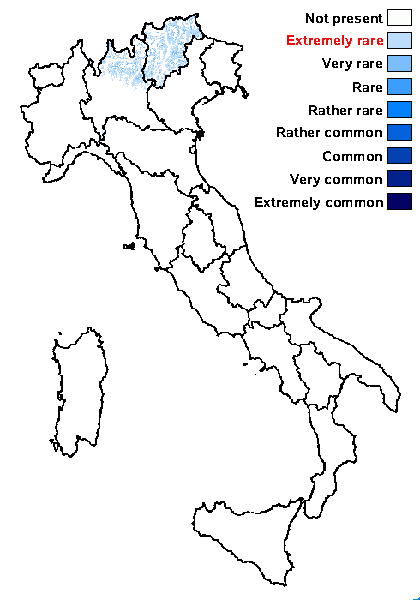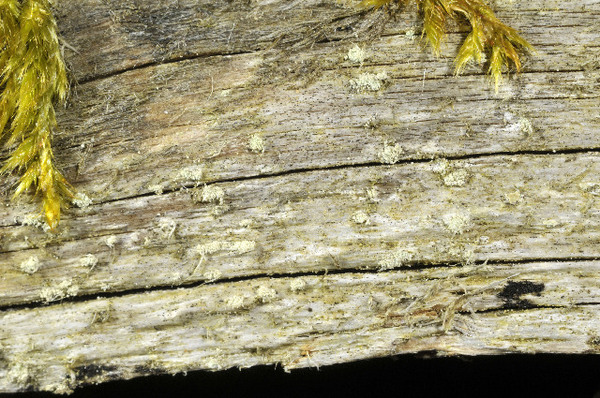Xylographa soralifera Holien & Tønsberg
Graphis Scripta, 20: 58, 2008.
Synonyms:
Distribution: N - TAA (Heininger & Spribille 2009), Lomb (Holien & Tønsberg 2008).
Description: Thallus crustose, endosubstratic to thinly episubstratic, continuous to more or less areolate, sorediate. Corticate parts pale grey or whitish grey; soralia whitish to cream-coloured becoming greenish, but often appearing grey-or brown-mottled due to pigmentation of the external soredia, with a firm internal cushion of mycelium, round to slightly elongated, 0.3-0.6 mm wide, mostly convex, often with a whitish margin, sometimes confluent. Soredia rather coarse, 14-26(-31) μm in diam.; enveloping hyphae short-celled, forming a more or less complete wall; consoredia 33-60 μm in diam. Apothecia often absent, round to narrowly ellipsoid, 0.1-0.3 x 0.2-0.8 mm, single or in clusters, with a flat to strongly concave, pale brown to flesh-coloured disc and a narrow and somewhat raised proper margin- Exciple pale brown; hymenium colourless, 100-170 μm high; paraphyses lax, 1 1.5(-2) μm thick, only slightly widened at tips; hypothecium colourless. Asci 8-spored, clavate-cylindrical, unitunicate, the gelatinous sheaths covering the walls amyloid, the tholus lacking internal amyloid structures, similar to that in Trapelia. Ascospores 1-celled, hyaline, ellipsoid to ovoid, 10-16 x 6-7 μm. Photobiont chlorococcoid. Spot tests: soredia K+ yellow turning dirty orange-red, C-, KC-, P + red (thallus P-). Chemistry: fumarprotocetraric acid.Note: a rather rare species occurring on lignum in upland areas, perhaps more widespread in the Alps.
Growth form: Crustose
Substrata: lignum
Photobiont: green algae other than Trentepohlia
Reproductive strategy: mainly asexual, by soredia, or soredia-like structures (e.g. blastidia)
Commonnes-rarity: (info)
Alpine belt: absent
Subalpine belt: very rare
Oromediterranean belt: absent
Montane belt: extremely rare
Submediterranean belt: absent
Padanian area: absent
Humid submediterranean belt: absent
Humid mediterranean belt: absent
Dry mediterranean belt: absent

Predictive model
Growth form: Crustose
Substrata: lignum
Photobiont: green algae other than Trentepohlia
Reproductive strategy: mainly asexual, by soredia, or soredia-like structures (e.g. blastidia)
Commonnes-rarity: (info)
Alpine belt: absent
Subalpine belt: very rare
Oromediterranean belt: absent
Montane belt: extremely rare
Submediterranean belt: absent
Padanian area: absent
Humid submediterranean belt: absent
Humid mediterranean belt: absent
Dry mediterranean belt: absent

Predictive model
 Index Fungorum
Index Fungorum
 GBIF
GBIF


